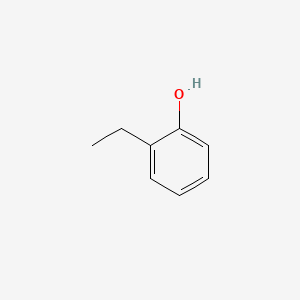D0668 | 2-ethylphenol
| Toxicity | Dose | Time | Species | Model | Method | Action | Positive criterion | Reference |
|---|---|---|---|---|---|---|---|---|
| MEMBRANE POTENTIAL | human | qHTS-HepG2 | MMP assay | Negative | IC50 | 163 | ||
| MEMBRANE POTENTIAL | 15.85 | human | HepG2 | MMP assay | decrease | IC50 | 163 | |
| MEMBRANE POTENTIAL | rat | hepatocytes | MMP assay | Negative | IC50 | 163 | ||
| Pictogram | Signal | Statements | Precautionary Statement Codes |
|---|---|---|---|
  |
Danger |
Aggregated GHS information provided by 462 companies from 9 notifications to the ECHA C&L Inventory. Each notification may be associated with multiple companies. H302 (64.94%): Harmful if swallowed [Warning Acute toxicity, oral] H312 (39.83%): Harmful in contact with skin [Warning Acute toxicity, dermal] H314 (36.15%): Causes severe skin burns and eye damage [Danger Skin corrosion/irritation] H315 (24.68%): Causes skin irritation [Warning Skin corrosion/irritation] H318 (36.8%): Causes serious eye damage [Danger Serious eye damage/eye irritation] H332 (38.96%): Harmful if inhaled [Warning Acute toxicity, inhalation] H335 (24.89%): May cause respiratory irritation [Warning Specific target organ toxicity, single exposure Respiratory tract irritation] Information may vary between notifications depending on impurities, additives, and other factors. The percentage value in parenthesis indicates the notified classification ratio from companies that provide hazard codes. Only hazard codes with percentage values above 10% are shown. |
P260, P261, P264, P270, P271, P280, P301+P312, P301+P330+P331, P302+P352, P303+P361+P353, P304+P312, P304+P340, P305+P351+P338, P310, P312, P321, P322, P330, P332+P313, P362, P363, P403+P233, P405, and P501; (The corresponding statement to each P-code can be found at the GHS Classification page.) |
  |
Danger |
H302: Harmful if swallowed [Warning Acute toxicity, oral] H318: Causes serious eye damage [Danger Serious eye damage/eye irritation] |
P264, P270, P280, P301+P312, P305+P351+P338, P310, P330, and P501; (The corresponding statement to each P-code can be found at the GHS Classification page.) |
 |
Warning |
H227: Combustible liquid [Warning Flammable liquids] H302: Harmful if swallowed [Warning Acute toxicity, oral] |
P210, P264, P270, P280, P301+P312, P330, P370+P378, P403+P235, and P501; (The corresponding statement to each P-code can be found at the GHS Classification page.) |
| 1-Ethyl-2-hydroxybenzene | 1-Hydroxy-2-ethylbenzene | 2-ETHYLPHENOL |
| 2-Ethyl-phenol | 2-Ethylphenol 100 microg/mL in Methanol | 2-Ethylphenol, 99% |
| 2-Ethylphenol, PESTANAL(R), analytical standard | 2-ethyl phenol | 25429-37-2 |
| 355O0P4JU7 | 4-06-00-03011 (Beilstein Handbook Reference) | 47721-EP2305625A1 |
| 47721-EP2311811A1 | 4CH-024566 | 90-00-6 |
| ACMC-1CHE2 | AKOS000119353 | ANW-39417 |
| BIDD:ER0661 | BRN 1099397 | Benzene, 1-ethyl-2-hydroxy- |
| C14385 | CAS-90-00-6 | CCRIS 6038 |
| CHEBI:34275 | CHEMBL321029 | CTK1A5796 |
| DB-021047 | DSSTox_CID_2479 | DSSTox_GSID_22479 |
| DSSTox_RID_76599 | DTXSID1022479 | E0160 |
| EINECS 201-958-4 | ETHYLPHENOL | FT-0612290 |
| Florol | Florol [Czech] | HSDB 5267 |
| IXQGCWUGDFDQMF-UHFFFAOYSA-N | InChI=1/C8H10O/c1-2-7-5-3-4-6-8(7)9/h3-6,9H,2H2,1H | J-509333 |
| JZ1; | KS-00000X95 | KSC205O9N |
| LS-1904 | MCULE-1491819809 | MFCD00002249 |
| NCGC00091780-01 | NCGC00091780-02 | NCGC00256439-01 |
| NCGC00259876-01 | NSC 10112 | NSC-10112 |
| NSC10112 | Phenol, 2-ethyl- | Phenol, ethyl- |
| Phenol, o-ethyl- | Phlorol | PubChem3871 |
| Q27115959 | RTR-033038 | SC-46756 |
| SCHEMBL51108 | SGCUT00114 | ST24040555 |
| STR06133 | TR-033038 | Tox21_202327 |
| Tox21_302885 | U021 | UNII-355O0P4JU7 |
| UNII-3JYG22FD73 component IXQGCWUGDFDQMF-UHFFFAOYSA-N | UNII-C27Y543KVA component IXQGCWUGDFDQMF-UHFFFAOYSA-N | Z1262253000 |
| ZINC1706027 | o-Ethyl phenol | o-Ethylphenol |
| o-Hydroxyethylbenzene | ortho-ethylphenol | to_000008 |

